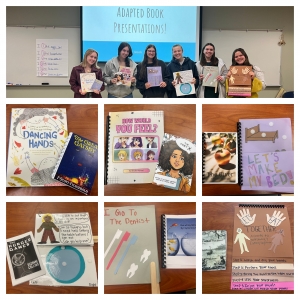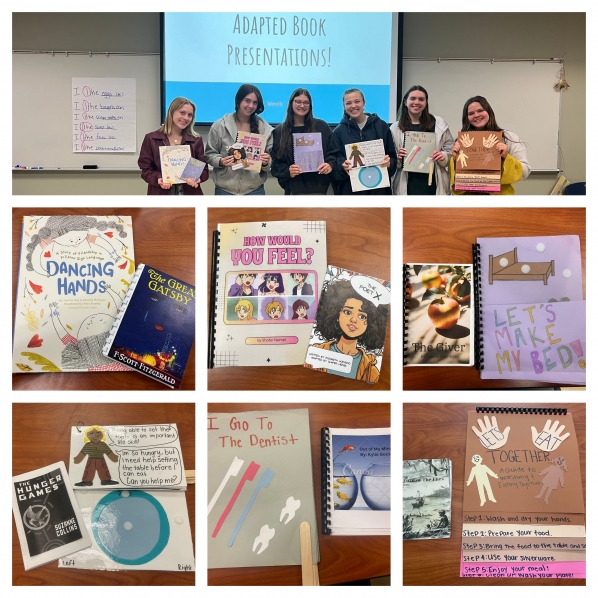One of the major assignments in Dr. Aftynne Cheek’s course “SPE 4410: Instruction and Support for Students with Developmental Disabilities and Extensive Support Needs” is creating adapted books, where students adapt books in ways that assist K-12 children with both cognitive and physical disabilities in access them. Adaptations range from creating visual representations of a story to adding sensory features such as textures and activities.
“What I love about this project is that students get to explore and use the many resources in the library,” said Cheek, who is the undergraduate and graduate special education program director and associate professor in the Department of Child Development, Literacy, and Special Education. “They receive instruction from Jennifer Woods, educational librarian, about choosing books that have characters with disabilities because representation matters.”
“Then they spend a day in the Makerspace creating books on their own,” continued Cheek. “The students enjoy being creative and making meaningful tools for their future students.”
“This project gives them a glimpse of one way they can make text meaningful and accessible to students with extensive support needs,” she added.
The goals of the course are to examine current issues and methods related to assessment, personalized curriculum development, and the planning, implementation, and evaluation of instruction of students with moderate and severe disabilities.
Students were allowed to adapt texts for two of three grade levels: elementary, middle, and high school students.
Students Utilize AI on the Assignment
When asked if they could use Artificial Intelligence (AI) on this project, the answer was “Yes!” Students were able to utilize AI to create their adaptable texts. They were given the parameters to “be creative” and “cite your resources.” Remarkably, many of them chose AI to help generate pictures while others used it to adapt the level of the text.
Tristin Ramsey, a senior special education major, utilized ChatGBT to summarize each chapter of The Great Gatsby and Canva AI, a graphic design tool, to create visual representations to accompany each chapter.
Gabbe Jennings experimented with ChatGPT to get different summary options. “First I asked for a summarized version of the chapter in one paragraph, and then I asked it to generate the same summary in a storytelling form for a high school student with special needs, and I was given the paragraphs I ended up with.”
“These adaptations allow students with more severe needs to access a piece of popular fiction/popular culture that a majority of their non-disabled same-age peers are engaging with,...[which can] open the doors for easier understanding of a text, allowing students more straightforward details and faster-paced storylines,” Jennings added. “Additionally, each page includes pictures that correspond with the given paragraph to allow for easier comprehension as well.”
Implementing in the Classroom
When designing their books, many of the students recounted experiences of working with children and adults with disabilities who needed adaptations.
For Jennings, she kept in mind an adult she works with who has a diagnosis of both Cerebral Palsy (CP) and autism.
“She loves to be able to have similar things to talk about with her peers and loves to be able to access different forms of media,” shared Jennings. “I wanted to make my book both readable and comprehensible for her to enjoy!”
Jennings also designed her book to not look like an adapted book.
“I chose these adaptations because I wanted to make this book accessible for students with disabilities while still allowing them to read it in a setting where it wouldn't stand out or look different,” noted Jennings. “My goal for this adapted book was to make the student with disabilities feel more connected with their peers as well as comfortable taking this around in any environment.”
“I think it is really important to give students with disabilities equal access to popular culture because this gives them an accessible bridge to making and keeping friendships with peers of their own age,” she continued.
When Hayley LaMontagne was creating her book that outlined the steps on how to eat and clean up, she had a certain student in mind that she had worked with many times in the past.
“This student is a nonverbal seven-year-old who does not yet know how to read. Although this student doesn’t know how to read, she absolutely loves books with different textures and colors on the pages and she loves picture books,” noted LaMontagne, a senior special education major. “I believe if this student and I read this book together it would get her excited to read it and she would become engaged in the book.”
“Another reason why I made this book for her is because one of her main goals at the moment is to be able to eat with silverware by herself,” LaMontagne added. “Not only is this book somewhat of a social story, but it’s also a chance for students to physically engage with the book while learning about how to properly eat and clean.”
Students also noted how they would use this assignment in their future classrooms.
“Educators create instruction tailored to individual students’ needs, therefore, the same should apply to literature,” said Shafer Heimel, a senior special education major. “I now understand the process of creating these books (planning, creating, assembling, etc.) and now know the estimated time it would take to prepare each type of book for my students.”
“Something I learned from making adapted books is that the possibilities are endless and there is always something you can do to a text to make it more accessible,” stated Kylie Gould. “I also learned that without these adaptations, a lot of books would be unreadable to students, and they would not be getting access to the curriculum. In the future, I would love to make all the books in my classroom adaptable so that all my students get to read and learn.”

